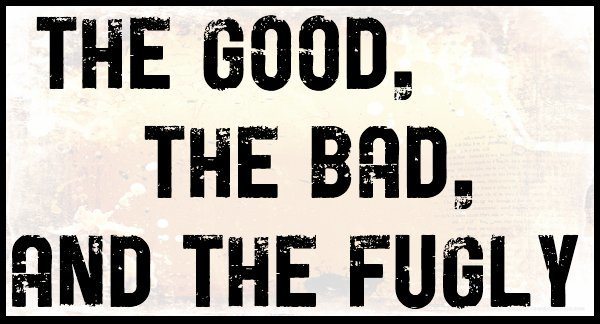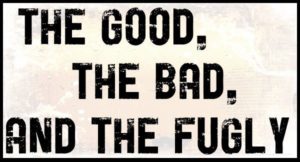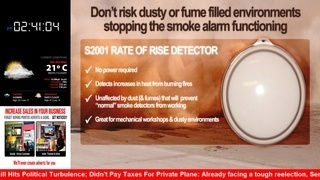
2011: Good, Bad and Fugly (Part 3)
December 30, 2011 by Dave Haynes
Part Three: The Fugly
Content Is One Fugly King

The majority of the creative running on screens in this sector is crappy because the good stuff costs real money. Usually BIG money.
The best and brightest creative minds aren’t paid $20/hour and hired straight out of some two-year technical college. They work at agencies and command studio rates that are many multiples of that.
The creative that wins awards in this sector often comes from creative agencies that barely know what this space is about. They have big-ticket brand clients who told them them they basically need This for That, and off they went. The five or six figure bill came later.
Most of what gets on screens in signage networks is produced by staff hires, whose job is to knock things out at volume for advertising clients who wouldn’t know what was even meant by a creative brief. They may have great talents and skills, but they are being asked to cook up a gourmet meal with a bag of Cheetos and some canned ham.
The limited number of creative groups dedicated to this space do what’s often much better work, but their client rosters are again limited by budgets. Even if what they charge is well below agency rates, it’s still beyond the budgets of a lot of projects. So we are left with a lot of creative that isn’t very compelling or impactful.
Here’s the thing, though. A lot of digital signage creative is crappy, but so is a lot of the creative on TV, radio, newspapers and online. There’s nothing new here. Budget, materials and no direction are issues across any medium.
Where content is truly fugly in this sector, on far too many networks, is on the programming side. That’s something far more easily remedied, and far less a slave to budget realities.
There are networks that have their formula down, and have spot-on programming wheels. But way, way, way too many networks persist with programming approaches that make little or no business sense.
Commodity information
If people really care about sabre-rattling in the Strait of Hormuz, who’s up in polling for the Iowa caucuses or the new hairstyle of a Kardashian, it’s so easy now to find it. Sports junkies can be plugged into their team or sport every waking moment, on multiple platforms. The weather is on everything … I mean EVERYTHING. So why do network operators continue to make this stuff the foundation of their programming strategy?
Because it’s readily available and steadily updated. It fills the yawning cavity between ad spots, which is what an ad network has to be most concerned about.
But it’s visual wallpaper, and any intercept surveys that ask people what they like and want to see, that suggests people LOVE seeing the news on these screens, would probably be torn to shreds by independent research analysts. Sticking up stuff that every other medium has is not an overly sound approach to building habitually viewing habits.
The first meetings, the first paragraphs on a business plan, should be about the programming strategy of a network – be that ad-based, retail or private. But programming look likes an after-thought on many networks.
Presentation
There’s not a lot of evidence in the field to support suggestions the industry has recognized the stupidity of heavily segmented screens. Technology, experience and common sense all indicate, strongly, that presenting multiple content zones on a screen makes no sense when the audience is transient, surrounded by distractions or has other things to command attention.
All news tickers and weather reports and pointless content streams – like check-ins – visually distract from the core message and intent of the screen. That may be advertising. That may be corporate communications. It might be retail calls to action. The screens were NOT put up to keep customers up on the headlines, or tell them the rainy spell should end by tonight.
I’ve seen video analytics from some retail projects that have screens in the aisles. People look for less than four seconds on average. Do you want them looking at your key message, or the time of day? “Oh God, look at the time. I’m late, I can’t shop another second. I need to leave!!!” Well played, fellas.
Context
Not enough thinking time is given to the context of the venue or circumstances.
Lazy thinking might get you to the conclusion that showing auto stuff in a car dealership waiting area is the height of brilliance. But there needs to be some deeper analysis about the context of the situation – what people would tend to be thinking about as it relates to why they are even there.
Again, in a car showroom, logic might lead you to think this is the perfect moment to upsell customers on accessories and special services. Emotional thinking might suggest the last thing a guy wants to see, as he waits to find out how much that rattle that just started under the car is going to cost, is a pitch to extract more money from him. Maybe the programming needs to reinforce how owning that particular auto brand – especially if it is a premium brand – is a little ego boost. Makes them think about buying the 2012 when it comes out. Or at least reinforces that quality has its price.
Easy to Say, But …
A big reason for all the Fugliness (possibly a new word) out there traces back to the same thing as creative. Programming also costs money, and keeping it steadily fresh and interesting is a BIG, expensive task.
The answer is not shovelware – the time-worn exercise of taking content developed and intended for one platform and shoveled on to another. We see it most, big surprise, with broadcast networks chopping up news and weather segments and making them available to Digital OOH networks. They used to do it to hopefully drive some people to the broadcasts. Now, in things like taxi and gas pump networks, they try to roll up those eyeballs as part of their overall (eroding) viewing audiences.
You can definitely take TV and make it work in Digital OOH, but doing it effectively is a lot more involved than cutting up .15 and .30 segments and gettingt them up on an FTP server. As has often been said, but not as frequently heeded, this is a distinct medium.
What We Need
Two things (at least):
1 – I hope in 2012 a true marketplace emerges, finally, for content for this medium. There have been a few highly flawed stabs at this, and I know through some conversations there are new efforts to develop something of a central buy, sell and distribution point for programming.
Digital OOH networks and some non-ad networks steadily produce content that could easily have new audiences if the branding was stripped out. I think they could re-sell it, recouping some of their costs and possibly developing a modest new revenue source. I also think it could be walled off so the content from Health Network A doesn’t find its way on a rival health network. That should be easy.
There’s also an opportunity for online, broadcast and hybrid new media networks that are serving many platforms to create and sell programming segments tuned to the medium. It’s been done and is being done, but it’s a lot of work and requires some luck even getting the parties together. There’s no eBay or Amazon for this stuff.
Finally, I think these is an opportunity for brands to do advertorial segments that some networks would use if the content value outweighed the obviousness of the commercial intent.
2 – To make this happen, standards are needed. There are some VERY elemental creative standards for Digital OOH now, but nothing that I know of for programming (though Bill Gerba and POPAI may have done a little work in this area).
For a marketplace to work, there would have to be standardized pricing structures, distribution methods, file formats, programming lengths, encoding and much more. Then there would have to be rules and codes of conduct about what’s OK, how things are labelled and flagged and so on.
It’s a big undertaking, but the company doing this becomes the crossroads for programming, and takes what amounts to a processing and agency fee every time stuff is bought and sold through that marketplace.
That would/should work great for some of the existing guys like ScreenFeed, as well as mainstream content companies like the Associated Press and Bloomberg that I assume would love to reduce the cost of sale and increase distribution in a largely untapped category.
More than anything, a marketplace would greatly improve the range of content available to networks. Costs would likely drop while more interesting and relevant content may boost ad recall and favorability numbers. That would make more networks more profitable, and make others actually viable.
Here’s hoping we see that in 2012, and that programming loses its too often Fugly visage.




Dave,
Awesome review of the year 2011 in the DS world! You hit the point in most cases. In Part 1 under QSRs you were right on. We’ve been saying this to our clients and in blog posts for three years now. Part 2 gave excellent insight to your readers when you said, “This is a maturing industry trying hard to build and hold credibility. Time to cut all the crap, fellas.” This is something we have tried to avoid at Noventri. And in Part 3 I loved that you gave insight on the use of multi-zone screens. This is something Noventri did away with about three years ago also. It is rewarding to see that Noventri is on the right track. Thanks for a good read.
Content is not King.
Context is King and Content is his prince.
— @virtualCableTV
Great comments, Dave. Could not agree more with your two concerns: content availability and standards.
From us at IAdea, HTML5 seems to be the one unifying platform that will solve both problems in 2012. We are seeing content providers creating live updating HTML5 content that can be easily changed from any mobile device or have pictures posted to them in real time. And the technology has made programming such content quite easy.
IAdea is committed to providing great devices that will play standard-compliant content with great reliability.
Thanks for the good series.